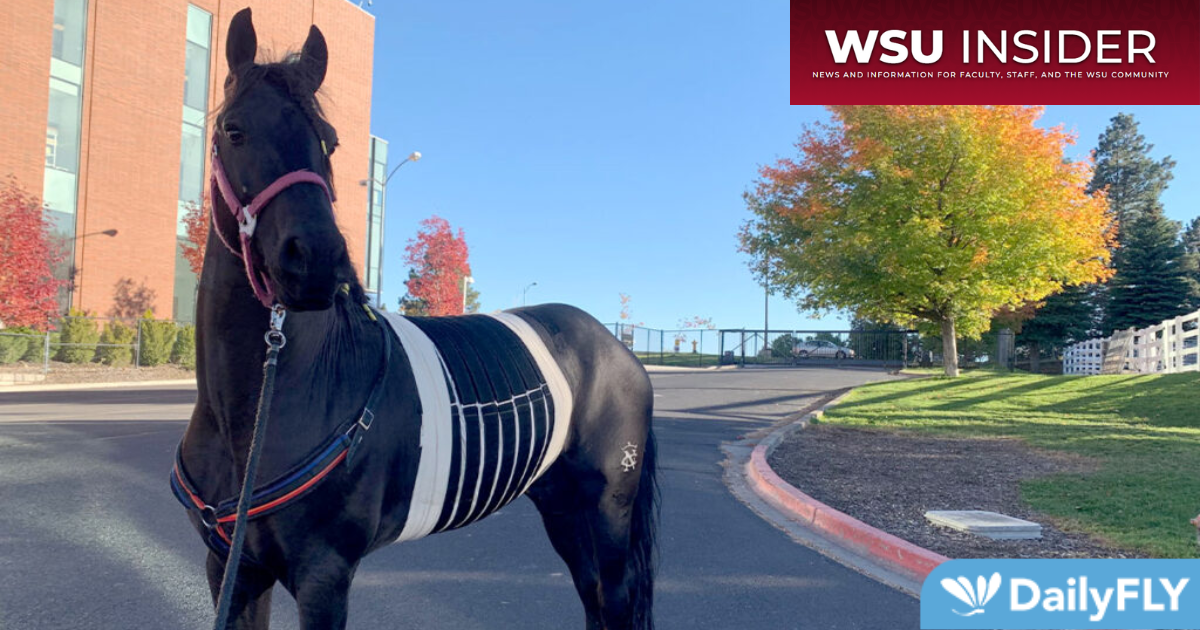The pair have settled into their new, temporary routine of short, calm strolls around the ranch — doctor’s orders. Nuñez, though, can see the horse is itching to run and resume his training for charro competitions, or horse dancing events, of which he has already shown exceptional skills in just one year of competing.
Getting back to dancing is secondary to Oro Negro’s health. He is only a short time removed from a month-long stay at Washington State University’s Veterinary Teaching Hospital after he underwent a pair of lifesaving colic surgeries and battled numerous serious complications.
“When you have a horse that has colic or needs help, every minute, every hour really counts when trying to save the horse,” Nuñez said. “If we hadn’t brought him into WSU when we did, he wouldn’t have made it.”
Colic, a broad veterinary term used to describe any form of abdominal pain, is one of the most common causes of death in horses worldwide. The severity of colic can vary greatly. Although most cases can be treated on the farm, a small percentage of horses need more intense treatment and even surgery. According to the United States Department of Agriculture, about 11% of the total cases result in a fatality.
Symptoms are often subtle, as was the case for Oro Negro.
“The day it happened, I got off from work and I came to the ranch,” Nuñez said. “He looked like he was totally fine, but for some reason, we felt like he was trying to give us a sign that he wasn’t feeling good.”
That little sign of discomfort was enough for Nuñez to keep a watchful eye on the horse. As the evening turned to night and finally early morning, Nuñez’s concern only amplified until he finally decided to load Oro Negro into his trailer and make the four-hour drive to Pullman at around 4 a.m.
“We could have tried to wait and get an appointment with a local veterinarian, but we really trust the doctors at WSU,” Nuñez said.
At WSU, Oro Negro was examined by staff in the equine service. He was quickly diagnosed with a large colon impaction. When medical intervention proved insufficient, Nuñez was told Oro Negro would need surgery to clear the impaction.
“It was really sad for us to leave him there and not know how he was going to do,” Nuñez said. “When they told us he needed surgery because he wasn’t responding to other treatments, I told them to do whatever they had to do to keep him alive, and that’s what they did.”
While most colic surgeries are relatively routine, Oro Negro’s quickly turned serious when his colon began to rupture and was for a moment only held together by the hands of a surgeon.
“That first surgery was intense for how close he was to rupturing his colon,” said Dr. Ana Rangel, an equine medicine resident who assisted with Oro Negro’s surgery and care. “It could have been fatal.”
Despite the success of the first surgery, Oro Negro’s battle was far from over. A second colic episode followed only days later, leading to another surgery and a cascade of complications, including low-grade pneumonia and an infected abdominal incision.
“He just developed all the complications you could possibly have,” Rangel said.
A month after arriving at WSU, Oro Negro was finally able to return home, although with strict instructions of six months rest time. His recovery has gone smoothly, and Nuñez is eager to resume Oro Negro’s training.
“His movements, he’s just really fast, and an amazing dancer. We are excited to get him back to competing again,” Nuñez said. “He’s a really special horse.”
